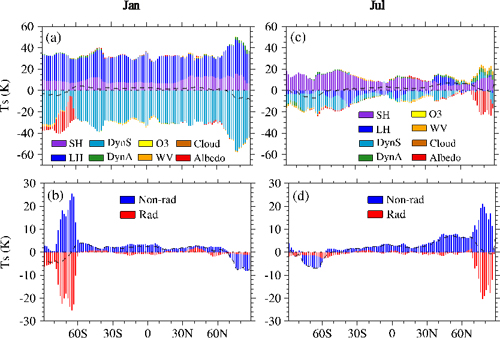Systematic model biases and their origins are identified to improve climate model performance
Date:2015-03-26
Atmospheric temperature (Ta) and surface temperature (Ts) are both elementary variables for characterizing the climate state and its changes. The reproducibility of the spatiotemporal changes of Ta and Ts in climate models is always regarded as an important metric of a model’s performance. Therefore, identifying the characteristics of model temperature biases and their origins is always one of the key challenges for model developers.
Prof. REN Rong-Cai’s research group from the Institute of Atmospheric Physics (IAP) applied a process-based decomposition method (CFRAM) which was developed on the basis of energy-balance of climate state, and provided quantitative information of the characteristics and origins of the systematic model temperature bias in the climate system model FGOALS-s2.
Their research results indicate that the Ts biases in FGOALS-s2 are generally larger over land than over oceans, and are mainly originated from the systematically overestimated downward heat fluxes in the model, plus the overestimated albedo locally in the southern subpolar region. The Ta biases in the winter hemisphere, particularly the “cold pole” bias in the northern polar stratosphere, are originated from the large model bias in representing dynamic processes; while the Ta biases in summer hemisphere are dominated by model bias in radiative processes.
Moreover, in contrast to what people generally believe, it's found that a small model temperature bias may not necessarily imply that the model has accurate representations of all the local radiative and non-radiative processes. Within the energy-balanced surface–atmosphere coupled system, any energy perturbation due to the model bias in any of the physical processes will lead to instant feedback responses of other physical processes, which will act to compensate for the bias by the initial energy perturbation. Scientists are therefore advised to pay more attention to the feedback and compensation existing among various non-radiative processes and between the radiative and non-radiative processes.
This series of research has been published in Climate Dynamics, Advances in Atmospheric Sciences, and Atmospheric and Oceanic Science Letters. The studies not only help to improve performance of FGOALS-s2, but also provide a reference to any other model system.
Reference:
R.-C. Ren*, Yang Yang, Ming Cai*, and Jian Rao, 2015: Understanding the systematic air temperature biases in a coupled climate system model through a process‐based decomposition method. Clim. Dyn., DOI: 10.1007/s00382-014-2435-7 (in press).
http://link.springer.com/article/10.1007/s00382-014-2435-7
Yang, Y., R. C. Ren*, M. Cai, and J. Rao, 2015: Attributing analysis on the model bias in surface temperature in the climate system model FGOALS-s2 through a process-based decomposition method. Adv. Atmos. Sci., 32(4), 457–469, DOI: 10.1007/s00376-014-4061-z.
http://link.springer.com/article/10.1007/s00376-014-4061-z
Yang, Y., and R.-C. Ren*, 2015: Understanding the global surface-atmosphere energy balance in FGOALS-s2 through an attribution analysis of the global temperature biases, Atmos Oceanic Sci. Lett., 8, 107-112, DOI:10.3878/AOSL20150019.

Zonal mean partial Ts biases (units: K) due to the radiative (Rad) processes including ozone (O3), water vapor (WV), cloud, and albedo feedback, and the non-radiative (Non-rad) processes including surface sensible heat flux (SH) and surface latent heat flux (LH), and dynamic processes at the surface (DynS) and in the atmosphere (DynA) in (a-b) boreal winter (January) and (c-d) boreal summer (July). The black dashed line denotes the total Ts bias relative to the ERA-Interim reanalysis.
